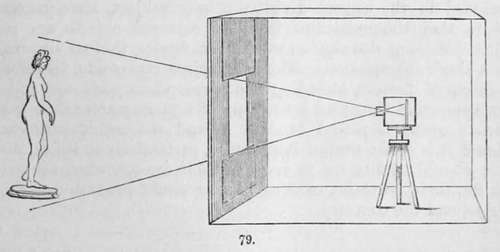Section II. Portraits From The Life
Description
This section is from the book "A Manual Of Photography", by Robert Hunt. Also available from Amazon: A Manual of Photography.
Section II. Portraits From The Life
It is important for the production of a correct likeness that as small an aperture as possible should be used. By doing this there is great loss of light, and consequently the necessarily prolonged time must be compensated for by greatly increased sensibility in the plates.
It is also important that arrangements should be made to cut off from the lens all light proceeding from extraneous objects: this is best effected by the modes adopted by M. Claudet.
The camera is placed, as shown in section, Fig. 79, within an arrangement of curtains which, as will be seen in the vignette heading to this part, page 175, is capable of adjustment, so as to have any required opening in front of the camera. The whole of this screen being mounted on rollers is easily moved; therefore the operator has it in his power to adjust the opening, and to shut off all adventitiuos radiations, thus securing the effectiveness of the rays proceeding directly from the sitter, or the object to be copied.

The sitter should be placed in the easiest possible position compatible with the arrangement of the body as nearly as is possible in a vertical plane. This is necessary, as the parts which are nearest the glass suffer a very considerable degree of distortion and enlargement. Of course great steadiness is required on the part of the sitter during the few seconds he submits to the operation of the photographer. It is usual to support the head by a rest fastened to the back of the seat, as shown in fig. 80; but where the person can maintain a steady position without this, the result is generally the most satisfactory, the "rest" not unfrequently giving an air of stiffness to the sitter. In a great number of portraits a dark and unnatural shade is thrown under the eyes: this arises from the employment of a "top light." The light falling vertically produces the shadow of the brow over the eye, and gives a sombre character to the face. This is objectionable also, as being annoying to the sitter, who assumes in consequence a somewhat painful expression.
Those who have attended to the analyses of the spectrum, included in the second division of our subject, have become aware that the radiations from all coloured objects are not alike. A long description would not render this so apparent as a single illustration. The frontispiece represents, therefore, a group of flowers, including the three primary colours, and a few compound tints; an exact copy of a photograph taken from such a group is placed beneath it, and the result is shown. Hence it is of the utmost importance, particularly to ladies, that they should be directed to avoid in their dresses, when about to sit for their portraits, such colours as would produce darks for lights, and the contrary.

Continue to:
- prev: Section I. Buildings, Statues, Landscapes, And Foliage
- Table of Contents
- next: Section III. Photographic Pentagraph
